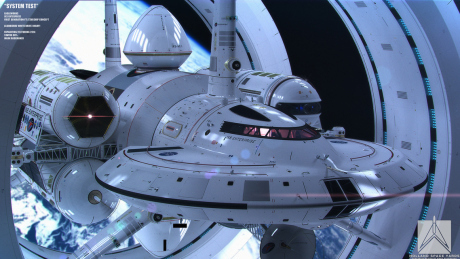Steven Lyle Jordan's Blog, page 46
June 15, 2014
DIY: Really nice Starbucks photo cup art
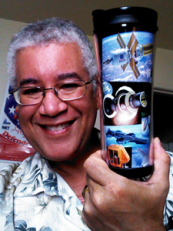 Having little (constructive) to do this weekend, I decided to update my Starbucks photo cup.
Having little (constructive) to do this weekend, I decided to update my Starbucks photo cup.
A Starbucks photo cup is a reusable cup which has an outer clear plastic body, and an inner layer that holds the drink, giving you space to slip art or photos in-between. You simply unscrew the bottom of the cup, slip your art between the layers, and screw the bottom back on. Very simple, very easy. And I did mention “reusable,” right? Better for the environment than using and throwing away plastic cups every day.
Some people like to slip in a picture of their kids or friends, or something of their favorite hobby or interest, a cool pic they took on last vacation, etc. I like the hobby bit; but I like to really make it kick.
So I work with photo manipulation software, a scanner and a color printer. A Starbucks photo cup comes with an insert that fits in the cup. Start by taking that insert out and scanning it to upload into your photo manipulation software. (I work in Photoshop, but any similar software will do.) Once uploaded, you have a shape to use as the template in which to put your art. I leave the background around the template as white, and usually select a background color for the template itself.
I save a lot of pictures of science- and sci-fi-related stuff, giving me tons of images to work with. If you don’t already have this, get online and start searching for and downloading photos of stuff you’re interested in. Upload each one to your photo software, and start loading them into the template shape. You can mix and match, change sizes and orientations, clip out backgrounds, arrange them in clever montages, anything you want.
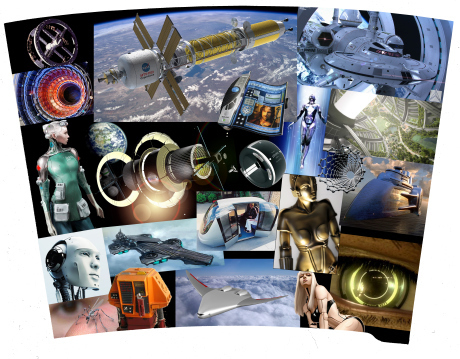
The finished image. Like this one? Save the full-sized image and print it for yourself!
When you’re done, send that bad boy to the color printer. Print your image at 100% size, just like you scanned it, and it should fit your cup perfectly. I recommend using glossy photo paper in the printer: It will not only give your art a snazzy look, but the paper is more durable than regular paper or card stock, allowing it to stand up better to the temperature variations, occasional humidity-driven moisture changes and direct sunlight that a reusable cup will inevitably suffer.
Print your template, then use a scissors or hobby knife to cut the template shape (having a white background against the color of your art makes this easy). Then remove the cup bottom and slide the image inside, using the tab at the bottom to push it into place.
Et violà! A custom-made, right-snazzy Starbucks cup that you can take anywhere and really show off your interests! And not just Starbucks; a lot of places will honor your request to put their drink into your cup. Sometimes I create templates of my novel covers, to give me a convenient ad product to show off and talk about. (You could always print out the one above and show it off, telling everyone about the great author who created it—and who, incidentally, would love it if you checked out his books! Just sayin’.)
Now that you’re properly accessorized, get out to your favorite cafe and knock ‘em dead!


June 14, 2014
Passive aggressive
 There’s an article on The Passive Voice in which authors are relating stories of having quit their day jobs to write full-time. The article, having gotten over 400 responses, has been the most popular posting on TPV since… ever. Comments range from those who are making more at writing than their day job, to those roughly matching their day-job salary, to those making significantly less than their day job, but having a few years’ savings to allow them to coast along while they hope for financial success.
There’s an article on The Passive Voice in which authors are relating stories of having quit their day jobs to write full-time. The article, having gotten over 400 responses, has been the most popular posting on TPV since… ever. Comments range from those who are making more at writing than their day job, to those roughly matching their day-job salary, to those making significantly less than their day job, but having a few years’ savings to allow them to coast along while they hope for financial success.
Some are calling it positive… encouraging… a Facebook acquaintance called it “an upper and a half.” I, personally, can only think of one word to describe it:
GGYAAAERRRRRRGH!
Okay, call me impatient… call me pessimistic… call me frustrated. But after years of writing and promotion, back to 2006… after taking off the last year of writing, to devote my time to promotion… after having written sixteen books, most of which have garnered average 4-star ratings and glowing reviews… and having so far earned, on average, about $5 a month from sales of all the books across the board… I’ve had to come to the conclusion that even a minimum wage job would earn me more than writing ever will.
How these other people manage to actually make a living doing this is so obviously beyond me that it’s downright pathetic.
So, yeah, seeing things like this isn’t encouraging to me. I liken it more like a Reaver ship’s spear through the heart.
So, I’m outta here for the rest of the weekend; I refuse to give a single brain cell’s effort to this writing crap.
(throws down mic, barely misses the cat)


June 13, 2014
FREE Reads
 Eyes left, dear visitors! Just in time for your summer reading pleasure, I’ve added a section of FREE Reads to the site, just under Original Novels.
Eyes left, dear visitors! Just in time for your summer reading pleasure, I’ve added a section of FREE Reads to the site, just under Original Novels.
FREE Reads will include the short story material I’ve written in the past, from my first story project, The Onuissance Cells, to the rousing action-adventure stories in Denial of Service, to any short stories that I create for general promotion. The Onuissance Cells stories and my latest short story, To the Other Side, are posted now. Enjoy!
(And don’t forget, there are even better novels waiting for you just above them.)


June 11, 2014
And speaking of interstellar spacecraft…
In 2012, NASA physicist Harold White revealed that he and a team were working on a design for a faster-than-light ship. Now he’s collaborated with an artist to create a new, more realistic design of what such a ship might actually look like. See the images in his Flickr gallery.
Pretty. Probably downright impossible… but pretty.


June 9, 2014
The debate over solar (freakin’) roadways
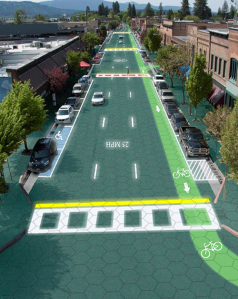 In 2009, the U.S. Federal Highway Administration (disclosure: I was once an employee of a Beltway Bandit working for the FHWA… so I know for a fact that they exist), seeking a way to deal with the high cost of building and maintaining the American road system, contracted a husband-and-wife team to develop an idea they’d already been working on, a mass-produceable road tile that would not only provide a suitable surface for vehicles, but actually generate power to create heat and light for itself, and to pump back into the nation’s energy grid.
In 2009, the U.S. Federal Highway Administration (disclosure: I was once an employee of a Beltway Bandit working for the FHWA… so I know for a fact that they exist), seeking a way to deal with the high cost of building and maintaining the American road system, contracted a husband-and-wife team to develop an idea they’d already been working on, a mass-produceable road tile that would not only provide a suitable surface for vehicles, but actually generate power to create heat and light for itself, and to pump back into the nation’s energy grid.
So began the entertaining saga of Solar Freakin’ Roadways.
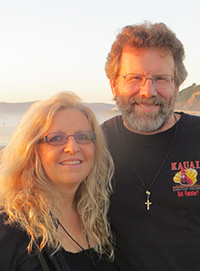 Scott Brusaw, an electrical engineer, and his wife Julie, a psychology counselor, developed their ideas out of existing technology and built them out of largely recycled materials. Their design was a layered hexagonal tile, topped with tempered glass molded for positive traction, and embedded with groups of solar cells and LED lights. Circuitry in each tile would allow the solar cells to collect energy, using some of it to power the LED lights, and in cold weather, using some of it to heat the tile, preventing snow and ice collection in all but the worst situations.
Scott Brusaw, an electrical engineer, and his wife Julie, a psychology counselor, developed their ideas out of existing technology and built them out of largely recycled materials. Their design was a layered hexagonal tile, topped with tempered glass molded for positive traction, and embedded with groups of solar cells and LED lights. Circuitry in each tile would allow the solar cells to collect energy, using some of it to power the LED lights, and in cold weather, using some of it to heat the tile, preventing snow and ice collection in all but the worst situations.
The LED lights would be intended to create illuminated lines or shapes on the road surface, replacing the painted lines and objects applied to roadways now. And any energy that wasn’t put into the lights or heating elements would be pumped into the electrical grid, possibly to provide power to electric vehicles in the future. The power produced by the tiles would pay back for their production, and one estimate suggests that if every street surface was covered with solar road tiles, they could provide three times the amount of energy used by America today.
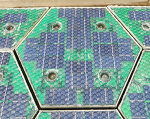 The tiles would be mass-produced on demand. In the event of a new road or breakage on an existing road, a truck with tiles and a few workers would arrive on-site and simply place or replace tiles as needed. Old or broken tiles could be fully recycled and used to make new tiles.
The tiles would be mass-produced on demand. In the event of a new road or breakage on an existing road, a truck with tiles and a few workers would arrive on-site and simply place or replace tiles as needed. Old or broken tiles could be fully recycled and used to make new tiles.
The tiles could be programmed to respond in various ways to outside signals, pressure, changing environmental and traffic conditions. They may aid communication with the self-driving cars being developed for our future driving needs, making them even smarter and safer. In addition, their addition to a road would include an access channel next to the road which would not only link the tile wiring to each other, but provide a channel for power and communications lines, and help channel stormwater runoff, aiding in erosion, water pollution and stormwater management control.
In 2014, the Brusaws delivered a proof-of-concept to the FHWA in the form of a parking lot section employing the tiles. They are presently crowdfunding an initiative to go from prototype to full production of the tiles, to allow those interested to start deploying them in parking lots, driveways, sidewalks and even outdoor sports spaces to demonstrate their potential to the public. In honor of their achievement, and to promote the crowdsourcing campaign, they created the highly entertaining Solar Freakin’ Roadways video, to explain the concept to those new to it. And here is where the controversy comes in.
Apparently, it’s become a thing for people to attack certain crowdfunding programs, and the Solar Roadways initiative was no exception. As naysayers came out, trying to blow holes in the Brusaws’ concept, one troll even appropriated the Brusaws’ video and tried to use it in an attack video of their own. Most (if not all) of the claims in the attack ad merely demonstrated the naysayer’s complete lack of knowledge of basic industry, finance, science, electronics and solar cell technology. Nonetheless, the Brusaws replied to the naysayer video, easily debunking its negative points.
At the time of this writing, the crowdfunding campaign has already earned more than twice its original goal. this is an initiative that could have game-changing potential nationwide, and needs to be seen to its logical conclusion: The replacement of much of our aging and inefficient road infrastructure with a 21st century system that is self-contained, modular, energy-efficient and environmentally sound.
I urge you to check out the Brusaws’ materials, and even to consider their crowdfunding campaign. I can think of a lot of worse things to spend your money on.


June 8, 2014
Built MISC tough
Driverless Cars: Optional by 2024, Mandatory by 2044
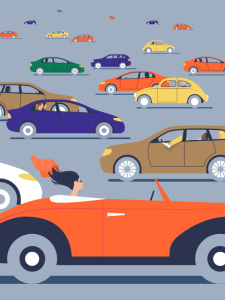 IEEE Spectrum is on my wavelength when it comes to autonomous driving. Their description of the future of driving mirrors the world I depicted in my novel Sarcology.
IEEE Spectrum is on my wavelength when it comes to autonomous driving. Their description of the future of driving mirrors the world I depicted in my novel Sarcology.


June 7, 2014
Excerpts are updated
 Just an FYI: I’ve updated the novel excerpts on these pages to match the excerpts I’m adding to the opening of each novel (which means, they are no longer simply the first three chapters of the book, but they are better representative of the overall feel of the novel). You’ll find the excerpts after each novel page in the Original Novels link.
Just an FYI: I’ve updated the novel excerpts on these pages to match the excerpts I’m adding to the opening of each novel (which means, they are no longer simply the first three chapters of the book, but they are better representative of the overall feel of the novel). You’ll find the excerpts after each novel page in the Original Novels link.
Go take a look, share with a few friends, and enjoy!


June 6, 2014
Laws for drones
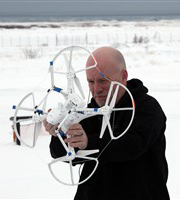 College of the North Atlantic made news recently when journalism instructor Jeff Ducharme developed a drone journalism code of conduct that his students will have to follow when using the unmanned aerial vehicle for news gathering.
College of the North Atlantic made news recently when journalism instructor Jeff Ducharme developed a drone journalism code of conduct that his students will have to follow when using the unmanned aerial vehicle for news gathering.
This is a significant step towards standardizing drone use in public and private spaces, a very contentious issue for our future.
Drones have incredible capability to provide information in realtime to authorities and private citizens, about all manner of things. Yet, as they are being prepped for daily use (and are being used now, in select areas), private citizens and institutions are concerned that people and organizations will use drones to violate personal and institutional privacy, potentially recording images and sound through windows or in screened back yards, etc.
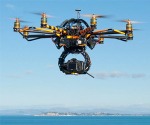 Because of this concern, drone use is severely restricted in the US, even as companies like Amazon and venues like ballparks try to figure out ways of monetizing them as delivery devices and remote cameras. (My novel Sarcology features drones used as autonomous delivery devices and surveillance equipment.) Civilians are largely restricted from operating them outside of their own property, or in certain limited areas. The technology essentially has a tight leash on it, restricting it from any useful functions.
Because of this concern, drone use is severely restricted in the US, even as companies like Amazon and venues like ballparks try to figure out ways of monetizing them as delivery devices and remote cameras. (My novel Sarcology features drones used as autonomous delivery devices and surveillance equipment.) Civilians are largely restricted from operating them outside of their own property, or in certain limited areas. The technology essentially has a tight leash on it, restricting it from any useful functions.
A set of clear laws are needed to provide reasonable procedures, guidelines and fair limitations that will allow any public or private user to operate the drones in a manner permissible to the public and private institutions.
Ducharme’s code of conduct document is a step in the right direction. Having written rules of conduct allows public scrutiny and government review, and can be rewritten to satisfy any lingering public or legal concerns. Further, they can be used to establish fines or punishments when the boundaries are breached.
Until such laws are ratified, drone use will continue to be tightly restricted in the US. But eventually, all public and private drone use in the US will be subject to such laws as will be inspired by or formed from documents like Ducharme’s codes of conduct. Once these laws and codes are in place, drones can take a useful place in our growing arsenal of useful technologies.
It may also be the opening salvo in a set of laws and codes of conduct for other autonomous devices that will enter the public space, from self-driving cars to automated security or personal assistance devices, designed to allow their use while keeping the public safe.


June 4, 2014
That thing you do
 I recently came across this via Facebook:
I recently came across this via Facebook:
“That thing you do, after your day job, in your free time, too early in the morning, too late at night. That thing you read about, write about, think about, in fact fantasize about. That thing you do when you’re all alone and there’s no one to impress, nothing to prove, no money to be made, simply a passion to pursue. That’s it. That’s your thing. That’s your heart, your guide. That’s the thing you must, must do.” –author unknown
Being that it had not been commented on when I discovered it, and being the person I am, I immediately had to come up with the most flip thing I could think of as a comment. My response was this:
“I should build my porn collection?”
(The response I received was equally apt: “Apparently so.”)
I honestly did spend a bit of time thinking about the question afterward, and trying to decide whether my writing counted as “the thing I do.” I also wondered, since these days I spend more time thinking about book promotion rather than actually writing, if that is my “thing.” (I sure hoped not, considering how much of a total failure I am at promotion.)
But eventually, I had to rule both of these out. I write because I enjoy it, but also because I want to make money at it; and I don’t spend all my time thinking about writing. I promote because it’s the only way to sell, and I think about it constantly now, but considering the fruit of my efforts it’s clearly not my forte.
And anyway, both of these take a back seat to the thing that I really spend most of my time thinking about, writing about, fantasizing about, and always seeking new ways to pursue. Yes, even my writing and promotion are done in pursuit of this.
My real passion is to make the world better. Everything I do is intended, to some extent or another, to help in accomplishing this. My desired reward is not money, impression, pride or proof; it’s the improvement of the world around me. That’s my thing.
What’s yours?



